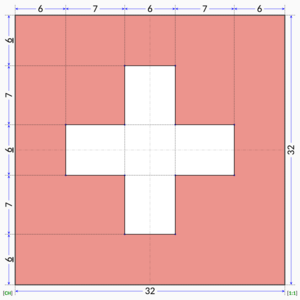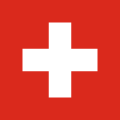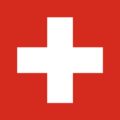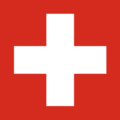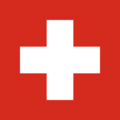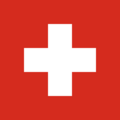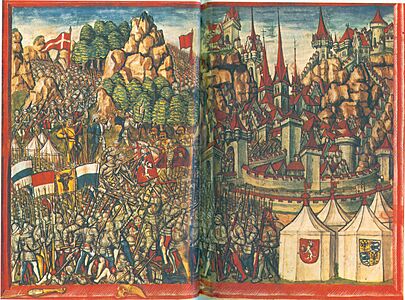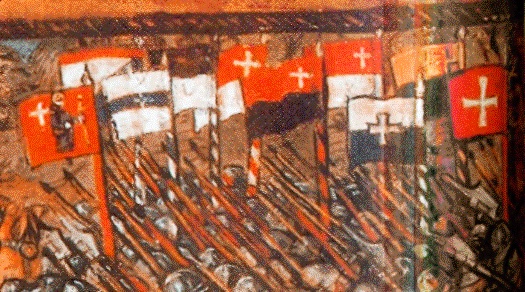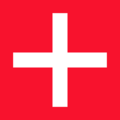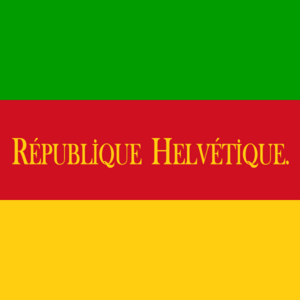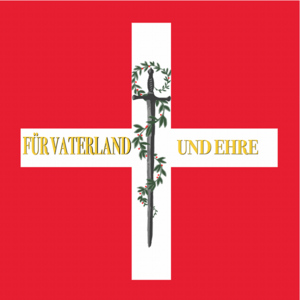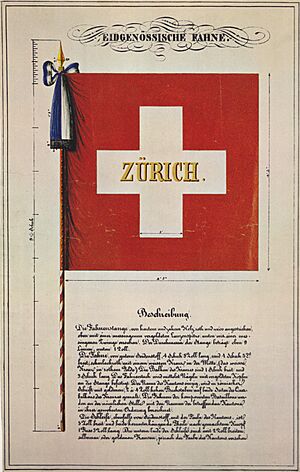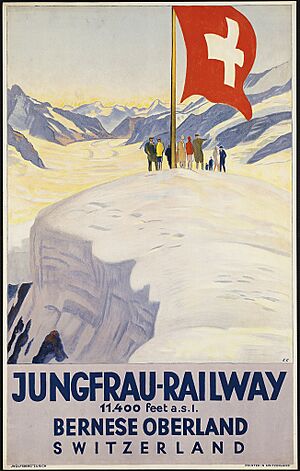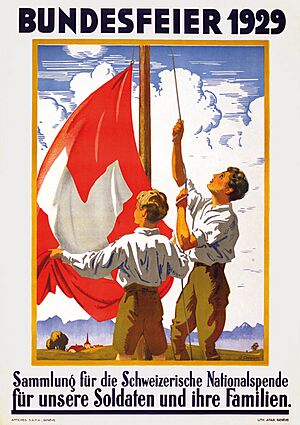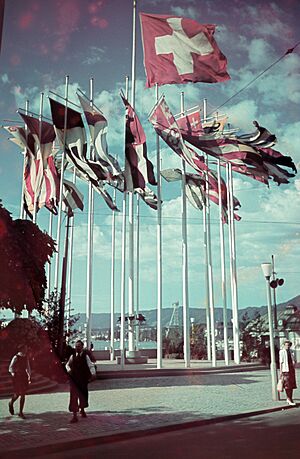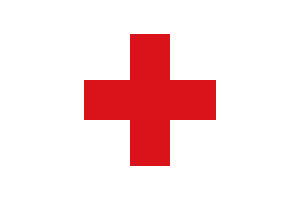Flag of Switzerland facts for kids
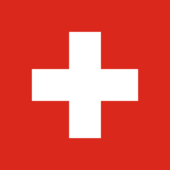 |
|
| Use | National flag |
|---|---|
| Proportion | 1:1 |
| Adopted | 1841 |
| Design | A red square flag with a white cross in the centre. |
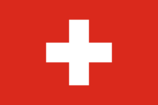
Civil and state ensign of Switzerland
|
|
| Use | Civil and state ensign |
| Proportion | 2:3 |
| Adopted | 1882 |
| Design | Red flag with a white cross in the center and a field (in vexillology the field of the flag is the background of the flag) of red. |
The national flag of Switzerland is a bright red square flag with a white cross in its center. This white cross is often called the Swiss cross or the federal cross. The arms of the cross are all the same length, and they are a bit longer than they are wide.
The Swiss flag is special because it's one of only two square national flags in the world. The other one belongs to Vatican City.
The white cross has been a symbol for the Old Swiss Confederacy since the late 1200s or early 1300s. Back then, it was used as a "field sign," which means it was attached to soldiers' clothes or to war flags to help identify them. In 1889, the Swiss Federal Council said the cross stands for both the Christian cross symbol and the old Swiss Confederacy.
The flag was first used as a national symbol during the Napoleonic Wars in the early 1800s. By 1841, it became the official flag for all Swiss troops. Today, the Swiss flag is a strong symbol of the country's history and values.
Switzerland also has a different flag for its ships and boats, called the civil ensign. This flag is rectangular, not square, but it still has the white cross on a red background.
Contents
How the Swiss Flag Looks
The Swiss flag is a white cross on a square red background. The cross is "free-standing," meaning it doesn't touch the edges of the flag. Each arm of the cross is the same size and is slightly longer than it is wide.
The official rules say the cross arms should be one-sixth longer than their width. The cross itself takes up about 5/8ths of the flag's height. This means there's a red border around the cross that is the same width as the cross arms.
Flag Proportions
The size of the cross compared to the flag was officially set in 2017. The cross is designed so that its total height is 5/8ths of the flag's height. This leaves a red border around the cross.
Many Swiss flags you see might have a slightly larger cross than these official rules, but the 5:8 ratio is the recommended one.
For the rectangular civil ensign, the cross also takes up 5/8ths of the flag's height.
Flag Colors
The red color of the Swiss flag is a pure, bright red. Before 2017, the exact shade of red wasn't officially defined. Now, it's set to a specific pure red color.
History of the Swiss Flag
Early History (Middle Ages)
The white cross symbol has a long history in Switzerland. Some stories say it came from the Theban Legion, a group of early Christian soldiers. Others link it to old war banners or to symbols of Christianity.
The white cross was first used to identify Swiss troops in the Battle of Laupen in 1339. Soldiers sewed white strips of cloth onto their clothing to tell themselves apart from their enemies, who used red or diagonal crosses.
The first time a flag with the white cross represented the entire Swiss Confederacy was possibly in the Battle of Arbedo in 1422. This flag was a red triangle with a long white cross.
So, the white cross started as a way to identify soldiers, and then it was added to the flags of different Swiss regions (called cantons). The flag of the canton of Schwyz, which was solid red, looked a lot like the later Swiss flag when the white cross was added to it.
Later History (Early Modern Period)
The first clear mention of a separate flag for the Swiss Confederacy was in 1540. It was described as "a red flag with a white upright cross." Because Switzerland became neutral, its troops didn't fight in many wars after 1540, so the federal flag wasn't used as much for military purposes.
However, the white cross became a symbol of the Confederacy itself. It appeared on medals and other items, even if it wasn't always on flags.
Later, in the 1600s, individual cantons started using flags with a white cross that reached the edges. These flags often had stripes in the canton's colors behind the cross. This led to the "flammé" style of military flag, which was popular for Swiss mercenary soldiers.
Napoleonic Era and Modern Flag
When France invaded Switzerland in 1798, the new government (the Helvetic Republic) replaced all the old flags with a green, red, and yellow flag. But after this period, the white cross on a red field came back.
In 1815, the Swiss government (the Tagsatzung) brought back the white cross in a red field for the country's official seal. This decision was kept when Switzerland became a federal state in 1848.
The white cross on a red field became very popular with private groups in the 1830s, especially shooting and gymnastics clubs. In 1841, the Tagsatzung officially chose a design by Carl Stauffer for all cantonal troops. This flag had a bold cross in the center of a square red field.
The current Swiss constitution, written in 1848, said that the federal flag should be used for all federal troops. In 1889, the Swiss Federal Council officially set the proportions of the cross. They said the cross was not just a shape, but a symbol of Christianity and the old Confederacy.
The rectangular version of the flag, used by ships, was officially introduced in 1953. The most recent flag law, from 2017, defines both the Swiss flag and the Swiss coat of arms using specific images.
How the Swiss Flag is Used
Private Use
Many people in Switzerland fly the flag from their homes and businesses all year round. This is especially true in rural areas. It's a way to show their love for their country. On Swiss National Day, August 1st, Swiss flags and banners decorate streets and buildings everywhere.
In recent years, it's become more common to see the Swiss flag on clothing and other items. This is part of a "Swissness" trend. The flag and coat of arms are also often used on products, especially high-quality goods or souvenirs for tourists. For example, the symbol of Victorinox, which makes Swiss Army knives, is based on the Swiss coat of arms.
Official Use
There aren't strict rules about how the flag is displayed on government buildings. Many public buildings have flagpoles for the federal, cantonal (regional), and municipal (city) flags. Sometimes, the flags are only flown on National Day or during special events. In Bern, the flag flies on the Federal Palace when the Swiss Parliament is meeting.
Legal Protection
It is against the law to destroy, remove, or disrespect a Swiss, cantonal, or municipal flag or coat of arms that has been put up by a public authority. Doing so can lead to a fine or even jail time.
There are also laws about using the Swiss cross, flag, or coat of arms for commercial purposes. While it used to be mostly allowed, new rules since 2017 aim to protect these symbols. Using the Swiss flag for business is generally allowed, as long as it's not misleading or against public rules.
Influence of the Swiss Flag
The Red Cross symbol, a red cross on a white background, is very famous. It was chosen as a protection symbol at the first Geneva Convention in 1864. The International Committee of the Red Cross says this design was created by reversing the colors of the Swiss flag. This was done to honor Switzerland, where the first Geneva Convention was held, and its co-founder, the Swiss Henry Dunant.
The modern flag of the Pontifical Swiss Guard, the Pope's personal army, also uses a Swiss cross design. It's based on the old flags of Swiss mercenary regiments from the 1700s.
See also
 In Spanish: Bandera de Suiza para niños
In Spanish: Bandera de Suiza para niños
- Coat of arms of Switzerland
- Flags and arms of cantons of Switzerland
- Flags and arms of municipalities of Switzerland
- Flag of the Red Cross


